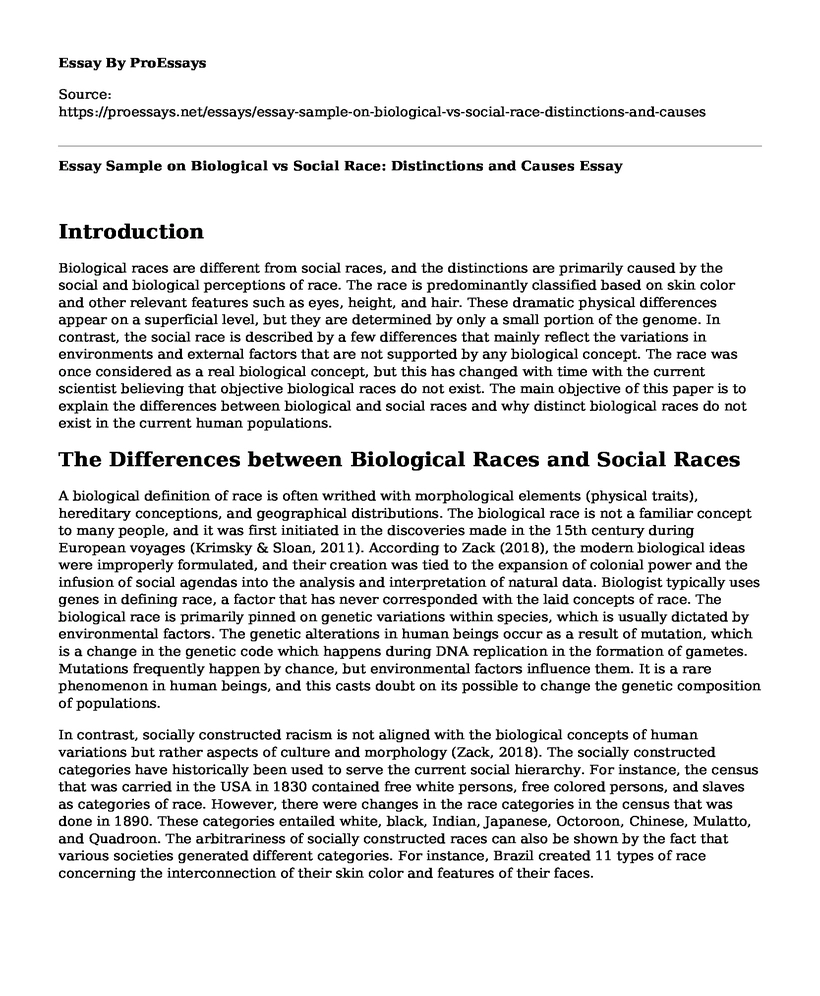Introduction
Biological races are different from social races, and the distinctions are primarily caused by the social and biological perceptions of race. The race is predominantly classified based on skin color and other relevant features such as eyes, height, and hair. These dramatic physical differences appear on a superficial level, but they are determined by only a small portion of the genome. In contrast, the social race is described by a few differences that mainly reflect the variations in environments and external factors that are not supported by any biological concept. The race was once considered as a real biological concept, but this has changed with time with the current scientist believing that objective biological races do not exist. The main objective of this paper is to explain the differences between biological and social races and why distinct biological races do not exist in the current human populations.
The Differences between Biological Races and Social Races
A biological definition of race is often writhed with morphological elements (physical traits), hereditary conceptions, and geographical distributions. The biological race is not a familiar concept to many people, and it was first initiated in the discoveries made in the 15th century during European voyages (Krimsky & Sloan, 2011). According to Zack (2018), the modern biological ideas were improperly formulated, and their creation was tied to the expansion of colonial power and the infusion of social agendas into the analysis and interpretation of natural data. Biologist typically uses genes in defining race, a factor that has never corresponded with the laid concepts of race. The biological race is primarily pinned on genetic variations within species, which is usually dictated by environmental factors. The genetic alterations in human beings occur as a result of mutation, which is a change in the genetic code which happens during DNA replication in the formation of gametes. Mutations frequently happen by chance, but environmental factors influence them. It is a rare phenomenon in human beings, and this casts doubt on its possible to change the genetic composition of populations.
In contrast, socially constructed racism is not aligned with the biological concepts of human variations but rather aspects of culture and morphology (Zack, 2018). The socially constructed categories have historically been used to serve the current social hierarchy. For instance, the census that was carried in the USA in 1830 contained free white persons, free colored persons, and slaves as categories of race. However, there were changes in the race categories in the census that was done in 1890. These categories entailed white, black, Indian, Japanese, Octoroon, Chinese, Mulatto, and Quadroon. The arbitrariness of socially constructed races can also be shown by the fact that various societies generated different categories. For instance, Brazil created 11 types of race concerning the interconnection of their skin color and features of their faces.
Reasons for Non-existence of Biological Races in the current Population
The current population cannot be classified using biological races since gene mutation is a rare phenomenon. Despite varying environmental factors across the globe, gene mutation rarely occurs in human beings, and given that it is the only basis by which biologists argue out a biological race, it is hard to categorize people using this criterion. According to the study that was carried out by Shulman and Glasgow (2010), there is no evidence to support the claim that races have distinct unifying genetic identities. Hence, the concept of biological race is ambiguous to the extent that two people from one region can be more genetically similar to a person from a different continent than they are to themselves.
References
Krimsky, S., & Sloan, K. (2011). Race and the Genetic Revolution: Science, Myth, and Culture. New York, NY: Columbia University Press.
Shulman, J. L., & Glasgow, J. (2010). Is Race-Thinking Biological or Social, and Does It Matter for Racism? An Exploratory Study. Journal of Social Philosophy, 41(3), 244-259. doi:10.1111/j.1467-9833.2010.01497.x
Zack, N. (2018). Race According to Biological Science. Philosophy of Race, 47-69. doi:10.1007/978-3-319-78729-9_3
Cite this page
Essay Sample on Biological vs Social Race: Distinctions and Causes. (2023, Feb 27). Retrieved from https://proessays.net/essays/essay-sample-on-biological-vs-social-race-distinctions-and-causes
If you are the original author of this essay and no longer wish to have it published on the ProEssays website, please click below to request its removal:
- The Benefits of Empowering Women to Society Essay Example
- Essay Example on 76.6% of Ex-Convicts Struggle to Re-Enter Society After Release
- Essay on Exploring Human Relationships: Differentiating Interactions and Characteristics
- Domestication: Taming Animals & Plants for Resources - Essay Sample
- Essay Sample on Courteous Civility in Society: Exploring Kindness & Incivility
- Paper Example on Madam Sindah's Bitter, Unprofessional Tone: Impact on Communication
- Essay Example on Berdache & Plymouth Settlement: Examining Gender Roles Across Cultures







